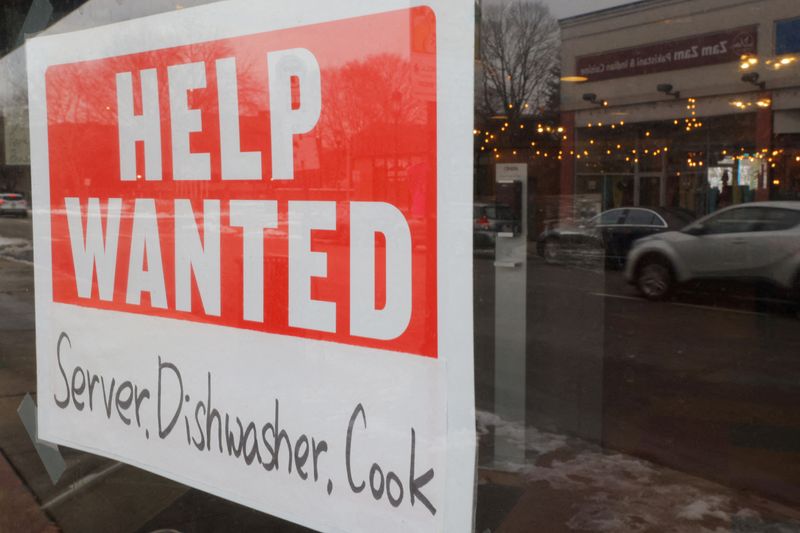By Lucia Mutikani
WASHINGTON (Reuters) - First-time applications for U.S. unemployment benefits drifted lower last week, but the number of people on jobless rolls jumped to a 2-1/2 year high in mid-June, suggesting that labor market conditions were easing amid slowing economic growth.
Ebbing economic momentum was underscored by other data on Thursday showing business spending on equipment declined in May, while a slump in exports pushed up the goods trade deficit. The stream of softer data on the heels of a sharp slowdown in economic growth in the first quarter increases the probability of the Federal Reserve cutting interest rates in September.
Retail sales were tepid in May and inflation pressures subsided considerably. Economists do not see the data as suggesting that a recession was imminent.
"The U.S. economy is on track for a soft landing, just what the Fed wants to see," said Sal Guatieri, a senior economist at BMO Capital Markets.
Initial claims for state unemployment benefits dropped 6,000 to a seasonally adjusted 233,000 for the week ended June 22, the Labor Department said. The claims data included last Wednesday's Juneteenth National Independence Day, a new holiday.
Claims tend to be volatile around public holidays. That volatility is likely to persist in the weeks ahead as automobile manufacturers typically idle plants after the July 4 Independence holiday for annual retooling.
Claims have risen to the upper end of their 194,000-243,000 range of this year. Economists are split on whether the recent increase in claims points to rising layoffs or the repeat of volatility experienced during the same time last year.
The elevation in applications was also attributed to a change in policy that came into effect in Minnesota last year allowing non-teaching educational staff to file for unemployment benefits during the summer break.
Claims are being monitored for signs whether employers are laying off more workers as the economy slows in response to the 525 basis points worth of interest rate hikes delivered by the U.S. central bank since 2022 to tame inflation.
"At this level, however, claims are not signaling a problem with continued job creation," said Conrad DeQuadros, senior economic advisor at Brean Capital.
The government confirmed in a separate report on Thursday that economic growth moderated sharply in the first quarter.
Gross domestic product increased at a slightly upwardly revised 1.4% annualized rate last quarter, the Commerce Department's Bureau of Economic Analysis said in its third estimate of GDP for the January-March quarter.
Growth was previously estimated at a 1.3% pace. The economy expanded at a 3.4% rate in the fourth quarter. While the growth pace likely picked up in the second quarter, it will probably not exceed a rate of 1.8%, which Fed officials regard as the non-inflationary growth pace.
The upward revision to first-quarter growth reflected upgrades to business and government spending as well as a lower level of imports. They offset a downgrade to consumer spending.
The Fed has maintained its benchmark overnight interest rate in the current 5.25%-5.50% range since last July. Though policymakers recently adopted a more hawkish outlook, financial markets expect the Fed to start its easing cycle in September.
Stocks on Wall Street were mostly higher. The dollar fell against a basket of currencies. U.S. Treasury prices rose.
RISING JOBLESSNESS
The number of people receiving benefits after an initial week of aid, a proxy for hiring, increased 18,000 to a seasonally adjusted 1.839 million during the week ending June 15, the highest level since late November 2021, the claims report showed. Economists cautioned against reading too much into the rise, noting the boost from Minnesota, which was likely to fade when schools opened for the new academic year.
The unadjusted so-called continuing claims for Minnesota increased 8,834 during the period under review. The overall continuing claims data covered the period during which the government surveyed households for June's unemployment rate.
Continuing claims increased between the May and June survey weeks. The jobless rate rose to 4.0% in May for the first time since January 2022. Most economists, however, did not view the rate at the current level as posing a danger to the labor market, arguing that the increase was concentrated among the 35-44 age group, recent immigrants and certain industries.
"Though job growth will slow, it will remain sufficient to limit a significant and broad-based increase in the unemployment rate," said Ryan Sweet, chief economist at Oxford Economics.
A separate report from the Commerce Department's Census Bureau showed non-defense capital goods orders excluding aircraft, a closely watched proxy for business spending plans, dropped 0.6% last month after rising 0.3% in April. Economists had forecast core capital goods orders edging up 0.1%.
Business spending on equipment is under pressure from the higher interest rates and softening demand for goods.
Core capital goods shipments dropped 0.5% after rising 0.4% in April. Non-defense capital goods orders decreased 0.9%, falling for a second straight month. Shipments of these goods tumbled 1.5% after increasing 2.1% in April. These shipments go into the calculation of the business spending on equipment component in the gross domestic product report.

Business spending on equipment rose marginally in the first quarter. A third report from the Census Bureau showed the goods trade deficit widened 2.7% to $100.6 billion last month as exports declined 2.7%. That suggested trade could again subtract from GDP growth this quarter. The drag could be offset by inventory accumulation, with stocks at wholesalers rising 0.6% in May. Retail inventories increased 0.7%.
"We find it hard to envisage a meaningful recovery in equipment investment anytime soon, given that long-term rates remain very high and credit conditions are tight, especially for smaller companies," said Oliver Allen, senior U.S. economist atPantheon Macroeconomics. "Trade and equipment investment are both set to drag on second-quarter growth."